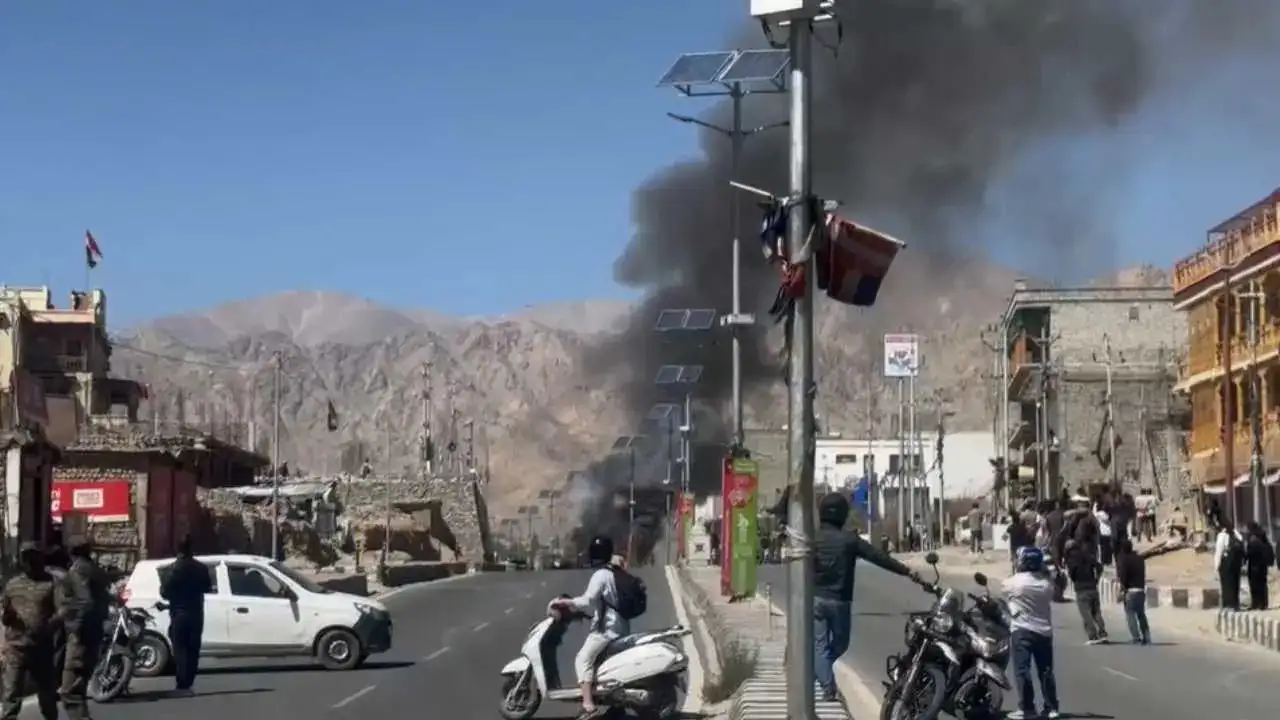The Truth Behind Leh-Ladakh Violence

- Lalit Garg-
The violent turn of the movement in Ladakh, demanding statehood and inclusion in the Sixth Schedule of the Constitution for special safeguards, is both unfortunate and alarming. Peaceful protests escalated into clashes with the police, arson, and destruction of property. A large number of demonstrators gathered in Leh, setting fire to the Bharatiya Janata Party office and vehicles parked outside. For a region known for its calm and serenity, this is an unprecedented incident. The immediate trigger was the health deterioration of environmentalist and social reformer Sonam Wangchuk, who, along with several others, had been on a hunger strike for two weeks. Their weakening condition inflamed public anger, eventually spilling into violence. This has raised disturbing questions—why did long-promised assurances remain unfulfilled? Why do locals feel increasingly insecure about their identity, culture, and rights?
In August 2019, when Articles 370 and 35A were abrogated, Ladakh was separated from Jammu and Kashmir and made a Union Territory. The government had promised that once conditions stabilized, full statehood would be restored. Locals believed this would safeguard their cultural and territorial rights. Instead, fears grew. Being governed directly from Delhi, people felt their aspirations were neglected. Over time, patience wore thin, leading Wangchuk to adopt a Gandhian path of peaceful protest—unfortunately, hijacked by violence. After the incident, Wangchuk ended his fast and appealed for peace, saying, “This violence has failed my message of non-violence. If our youth take the wrong path, our true objectives will be lost.”
Indeed, Ladakh’s disciplined and conscious society needs to remain vigilant and sensitive. Despite his disagreements with the government, Wangchuk never abandoned dialogue. His supporters must understand that violence only complicates matters. Given Ladakh’s strategic geography, bordering China, law and order must remain a priority. The creation of Ladakh as a Union Territory was seen as a new dawn, freeing it from Kashmir’s dominance. Yet political ambitions and narrow interests have clouded that promise.
Following the arson, communication restrictions were imposed across Ladakh. Reports of casualties emerged, while a “Leh Bandh” shut down the town with large youth participation. The protests escalated into violent resistance. Opposition parties in Jammu and Kashmir blamed the Centre, insisting the movement reflects genuine concerns for Ladakhi identity and employment. Ironically, talks between the Centre and local bodies—the Leh Apex Body (LAB) and Kargil Democratic Alliance (KDA)—were already scheduled for October 6, 2025. Why then did protests erupt prematurely? The answer lies in distrust: Ladakhis feel excluded from decision-making and fear reckless exploitation of their natural resources.
People are demanding not only statehood but also inclusion in the Sixth Schedule, which guarantees protection of land, culture, and employment opportunities. Unemployment has worsened discontent. Before 2019, Ladakhi youth could apply for gazetted posts through the Jammu & Kashmir Public Service Commission. That avenue closed after UT formation, leaving them to compete nationally through the Union Public Service Commission, where they feel disadvantaged. At the same time, no special recruitment drives for locals were launched. The growing job crisis, coupled with weakened Hill Development Councils and centralization of decision-making in Delhi, has deepened alienation.
The demands also include separate Lok Sabha representation for Leh and Kargil, and priority in government jobs for locals. Under Article 244, the Sixth Schedule provides for autonomous councils empowered to protect resources and culture. The erosion of such autonomy in Ladakh has left locals fearful of losing their land, livelihoods, and voice. When dialogue and trust are absent for too long, patience eventually snaps. What we see today is not just a demand for statehood—it is a struggle for self-determination, identity, and justice.
The people of Ladakh want constitutional guarantees, resource protection, and meaningful participation in governance. Had earlier assurances been implemented in a time-bound and transparent manner, the crisis might never have escalated. Today, what is urgently needed is confidence-building through dialogue, constitutional safeguards, stronger local representation, and robust employment and education programs. Only then can anger be transformed into trust, and violence into peace. The government must assure Ladakhis that their interests are protected, while the people too must recognize that not every demand can be met instantly. The best path forward lies in transparency and mutual trust—because violence is never a solution, but dialogue always is.
साभार :
© CopyRight Pressnote.in | A Avid Web Solutions Venture.






